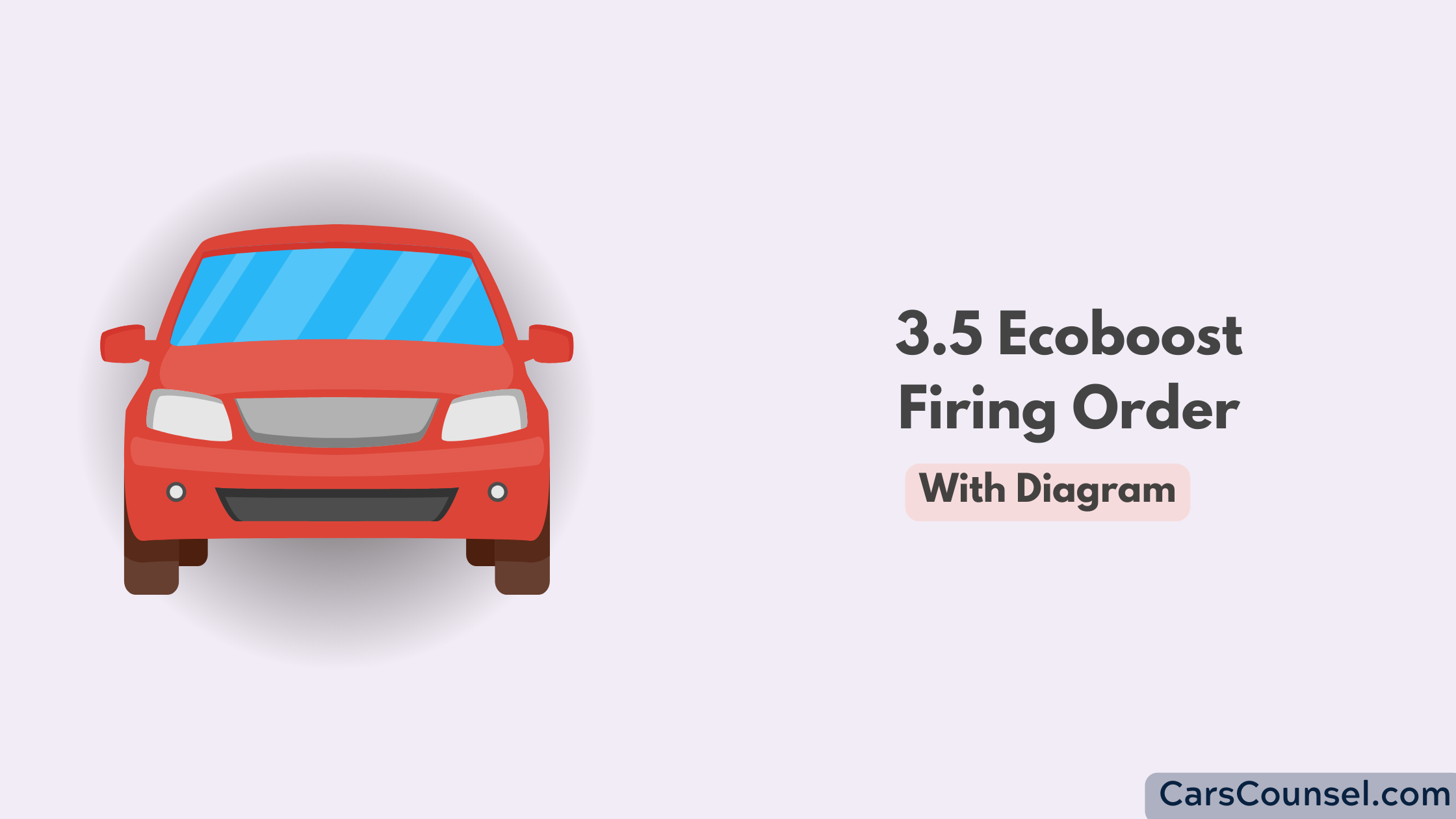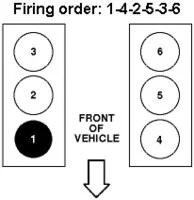The way your 3.5L Ecoboost engine fires is in this order: 1-4-2-5-3-6. It’s important this order is followed for the engine to work well and without any noise or shaking. This kind of engine is often found in cars like the Ford F-150 and Lincoln Navigator.

It starts with the first cylinder at the front of the engine. If there are any misfires, especially in cylinders 5 and 6, it could mean that something’s not right. By learning more about this, you’ll understand better how your engine works and why it might misfire.
Quick Navigation
Key Takeaways
- The way the 3.5 Ecoboost engine fires is in this order: 1, 4, 2, 5, 3, 6. The first cylinder is located at the front part of the engine.
- This type of engine setup is commonly seen in cars like the Ford F-150, Ford Pioneer, and Ford Taurus SHO.
- It’s really important that the right amount of force is used when tightening the main cap bolts (60-70 foot-pounds) and the cylinder head bolts (65-72 foot-pounds).
- Problems with spark plugs, ignition coils, or fuel systems can often lead to misfires in cylinders 5 and 6.
- The cylinders of the engine are arranged in a V shape. The numbering starts on the left side and switches between the sides.
Understanding 3.5 Ecoboost Firing Order

To really get the 3.5 Ecoboost firing order, you need to know that the engine has a V shape with three cylinders on each side. The firing starts with the first cylinder, then it goes back and forth between the sides for the best balance and performance.
The order is 1-4-2-5-3-6, which helps the engine run smoothly and perform at its best. This setup keeps the engine steady and avoids extra noise or shaking that can come from an uneven firing order.
The first cylinder is at the front of the engine, and the rest follow in order, switching between the left and right sides. If something goes wrong with this order, it can cause misfires and affect how well the engine works. So, knowing this order can help keep your car running at its best.
Applicable Vehicles and Models
Knowing the firing order of the 3.5 Ecoboost engine isn’t just for car mechanics; it’s also helpful for everyday drivers to understand which car models this applies to. This specific firing order is compatible with various Ford models, especially the Ford F-150 and Ford Pioneer. Both these models use the 3.5L Ecoboost engine, and their performance relies heavily on the correct firing sequence of 1-4-2-5-3-6.
Other models that use this engine include the Ford Taurus, specifically the SHO version. The Ford Expedition and Lincoln Navigator also use the 3.5L Ecoboost engine. Knowing which models use this firing order can help you make better decisions about your car’s maintenance and performance.
Key Torque Specifications
The way your car runs depends a lot on getting the right amount of tightness, or torque, on different parts of your 3.5 Ecoboost engine.
When you’re looking after your engine or trying to get it to run better, it’s really important to know the right levels of tightness for different parts. Here’s a quick guide:
- Main cap bolts: These need to be tightened to between 60 and 70 foot-pounds.
- Connecting rod bolts: These need between 22 and 25 foot-pounds of tightness.
- Cylinder head bolts: These should be tightened to between 65 and 72 foot-pounds.
- Rocker arms and Intake manifold bolts: Tighten these to between 17 and 23 and 23 and 25 foot-pounds.
Getting these right helps your engine work well and last a long time. Remember, making parts too tight can cause as many problems as not making them tight enough, so always follow these guides.
Causes of 3.5 Ecoboost Misfires
If your 3.5 Ecoboost engine is not working properly and is misfiring, particularly in cylinders 5 and 6, it’s a pretty common problem. These misfires can cause your engine to not work as well as it should, so it’s important to figure out why it’s happening to keep your engine running smoothly.
Misfires often happen because of problems with the spark plugs, issues with the ignition coil, or when the fuel system isn’t working properly. Knowing these causes can help you find ways to stop the misfires.
Here’s a simple guide to help you:
| Reason for Misfire | Signs | What to Do |
|---|---|---|
| Problems with Spark Plugs | Engine idles roughly, slow speed-up | Change the spark plugs |
| Ignition Coil Problems | Engine shakes, power is less | Check the coils, change them if needed |
| Fuel System Not Working Properly | Bad fuel usage, engine stops suddenly | Clean or change the fuel injectors |
Firing Orders in Similar Engines
Just like the 3.5 Ecoboost, other engines also have their own special firing orders that help them work best and stay balanced. Understanding the firing order is key to making sure the engine works at its best.
Let’s look at the firing orders of some engines that are similar:
- For the Ford FE engine series, which includes the 352/360/390/406/410/427/428, they all use the same firing order, which is 1-5-4-2-6-3-7-8.
- The Ford 385 series uses the same firing order as the Ford FE series, which is 1-5-4-2-6-3-7-8.
- The Big Block series, particularly the 429/460, also uses this order.
These firing orders are designed to minimize shaking and keep the engine balanced. If you get these orders mixed up, the engine mightn’t fire properly, which can affect how well it works and how much fuel it uses. So, it’s really important to use the right firing order for each type of engine.
Cylinder Numbering and Placement
Knowing how the cylinders are numbered and placed in the 3.5 Ecoboost engine is really important for the engine to work well and for keeping it in good shape. This engine’s cylinders are set up in a “V” shape, with three cylinders on each side. This special setup helps the engine to work better.
Here’s a simple chart to help you see how the cylinders are numbered:
| Left Side | Right Side |
|---|---|
| Cylinder 1 | Cylinder 2 |
| Cylinder 3 | Cylinder 4 |
| Cylinder 5 | Cylinder 6 |
The numbering starts with cylinder 1 on the left side, then goes to cylinder 2 on the right side. It keeps switching sides, which makes the engine balanced and work better. It’s really important to understand this setup to keep your 3.5 Ecoboost engine in good shape.
Dealing With Engine Misfires
Handling engine misfires in your 3.5 EcoBoost may feel like a tough job, but if you know what you’re doing, you can handle it effectively. Engine misfires can make your vehicle not work as well and can make it use more fuel.
Here are some simple ways to help you fix this problem:
- Look at your Spark Plugs: If your spark plugs are damaged or old, they could cause misfires. You might need to replace them.
- Check your Fuel Injectors: If your injectors are blocked, they could cause misfires. You might need to clean or replace them to make sure the fuel gets to the engine properly.
- Look at your Ignition Coils: If your coils aren’t working right, they could cause misfires. You could replace them with better ones to make your engine work better.
- Check your Air Intake System: If your air intake system isn’t working right, it could also cause misfires. You need to make sure it’s working well.
Importance of Correct Firing Order
Why should you care about the firing order in your 3.5 EcoBoost engine?
Well, the firing order, which is just the order in which the spark plugs light up the cylinders, plays a big role in how well your engine works and when the spark plugs ignite. If it’s correct, your engine will run smoothly, giving you the most power and best fuel economy. If it’s wrong, you might’ve engine misfires, lose power, and increase emissions.
The firing order also helps keep the engine balanced. This cuts down on shaking and can help your engine last longer.
Conclusion
So, there you go – everything you need to know about the 3.5 Ecoboost firing order.
Think of it like a team leader directing a team, the right firing order makes sure every cylinder does its job at the right time, making your engine powerful and efficient.
Remember, if a cylinder misfires, it’s like a team member missing their cue, and it can mess up the whole operation.
So, keep this guide close by, and let your engine work at its best, thanks to your new knowledge about how it works.

